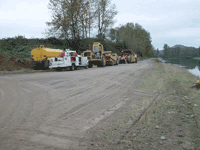 Whether working as heavy equipment operators, mechanics, or surveyors, operating engineers can be found on any project using construction equipment. "Heavy equipment" is the blanket term for numerous types of machines: cranes, bulldozers, front end loaders, rollers, backhoes, graders, dredges, hoists, drills, pumps and compressors are just some of the equipment used by operating engineers. We are also called hoisting and portable engineers because the equipment we operate lifts and/or moves.
Whether working as heavy equipment operators, mechanics, or surveyors, operating engineers can be found on any project using construction equipment. "Heavy equipment" is the blanket term for numerous types of machines: cranes, bulldozers, front end loaders, rollers, backhoes, graders, dredges, hoists, drills, pumps and compressors are just some of the equipment used by operating engineers. We are also called hoisting and portable engineers because the equipment we operate lifts and/or moves.
In most cases, if it can push, pull, pump or lift material, rolls on tires or crawls on tracks like a tank, it’s the work of IUOE. On virtually all construction projects, operating engineers are the first workers on the job and the last to leave. Our work is essential to a smooth-running construction project.
Although many members have a favorite type of machine to operate, operating engineers are masters of a variety of equipment. This versatility keeps us employable because employers' needs vary from project to project.
 Heavy equipment mechanics and surveyors also are very important contributors on any construction job. Mechanics repair and maintain the equipment used on the job, requiring a thorough knowledge of many types of equipment. Skilled mechanics are critical because if the equipment isn't running when needed, an entire project can come to a screeching halt.
Heavy equipment mechanics and surveyors also are very important contributors on any construction job. Mechanics repair and maintain the equipment used on the job, requiring a thorough knowledge of many types of equipment. Skilled mechanics are critical because if the equipment isn't running when needed, an entire project can come to a screeching halt.
Surveyors use expertise in linear and angular measurements to lay out the geographical boundaries of a construction project. A surveyor must have a good command of advanced math principles because this type of work is extremely precise.
What do I need to become an operating engineer?
-
Three to four years of apprentice training, including on-the-job, field and classroom training
-
A good work ethic and, because you will be working on expensive and potentially dangerous equipment around other people, a responsible attitude
-
An interest in working outdoors
-
Reliable transportation
-
The ability to work “regular” construction hours of 6:00 or 8:00 a.m. to 5:00 or 6:00 p.m., as well as overtime at short notice or swing shifts on some projects
-
The ability to work for many different employers during your career
-
An understanding that you may be out of work during seasonal down-time in the construction industry
In most IUOE local unions, members are dispatched to work from a roster which may be called a referral or an out-of-work list. This list is ordinarily based on length of time out of work, which means that those members who have been laid off the longest usually are sent out first.
What training does IUOE provide for apprentice operating engineers?
 IUOE locals provide excellent skills development training programs nationwide, and most are registered with a state or federal apprenticeship agency. These heavy equipment operator training schools are designed to give someone who knows little or nothing about the trade the opportunity to earn while they learn.
IUOE locals provide excellent skills development training programs nationwide, and most are registered with a state or federal apprenticeship agency. These heavy equipment operator training schools are designed to give someone who knows little or nothing about the trade the opportunity to earn while they learn.
The average length of an operating engineer apprenticeship is three to four years. Apprentices learn their trade by working with skilled journey level operators on actual job sites and attending related classroom instruction and field training.
After completing an apprenticeship, many journey workers take additional training classes offered by their local. Continued training upgrades members’ skills, making them more employable. It has also helped many IUOE members move on to management or supervisory positions.
How much do operating engineers earn?

Journey level and apprentice earnings vary considerably from one part of the country to another, so you will need to contact the IUOE local in your area for specific information. Starting pay for an apprentice varies from one local to another, from 45% to 60% of the journey level rate. Pay increases are scheduled at designated times during apprenticeship and are negotiated as part of each local’s contract with employers. During the final year of apprenticeship, wages are typically 80% to 90% of the journey level rate.
In most IUOE local unions, members are dispatched to work from a roster which may be called a referral or an out-of-work list. This list is ordinarily based on length of time out of work, which means that those members who have been laid off the longest are sent out first.